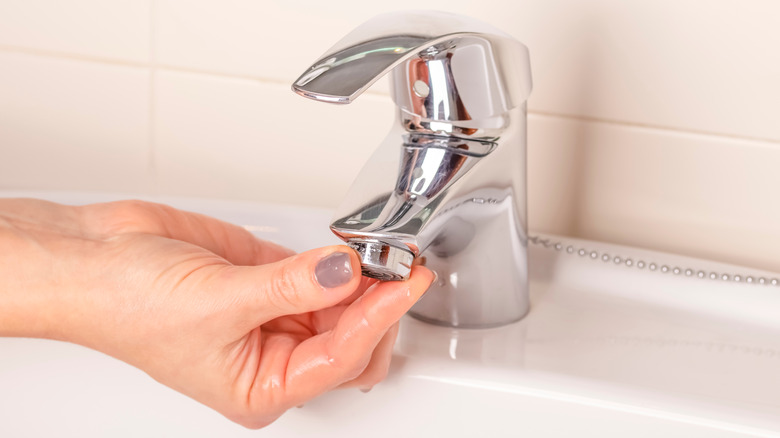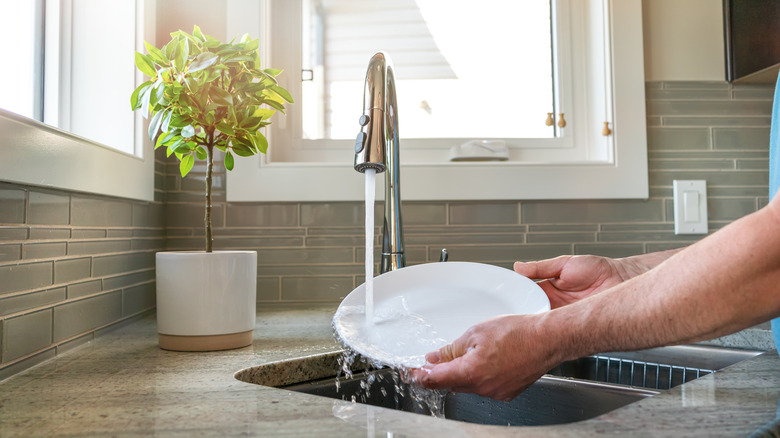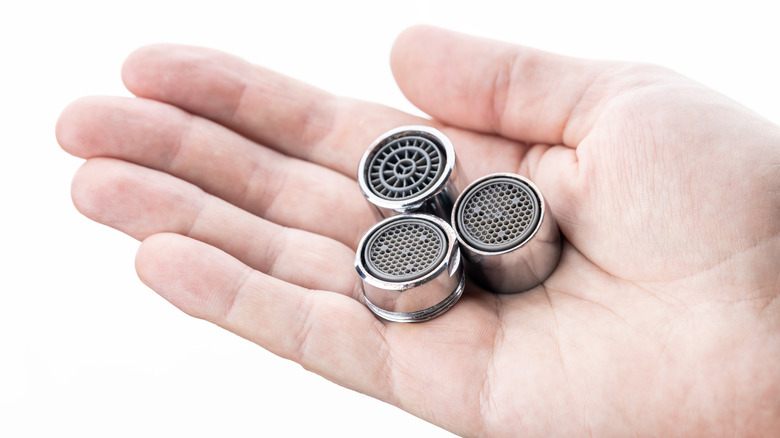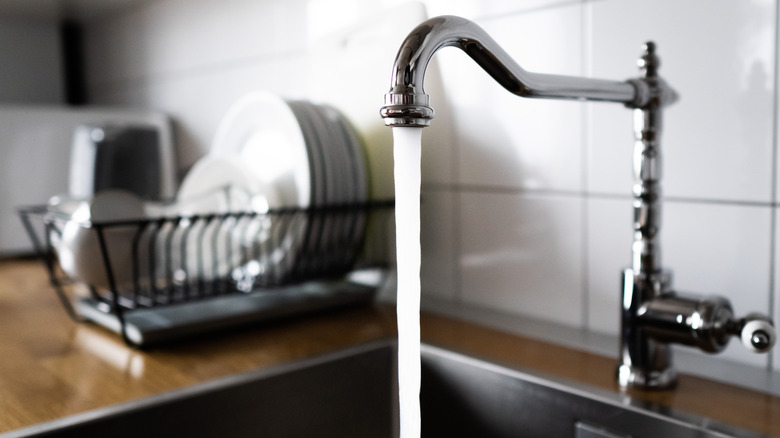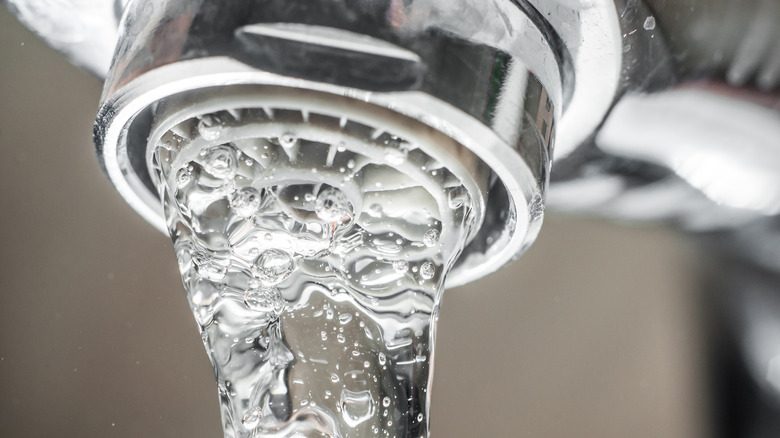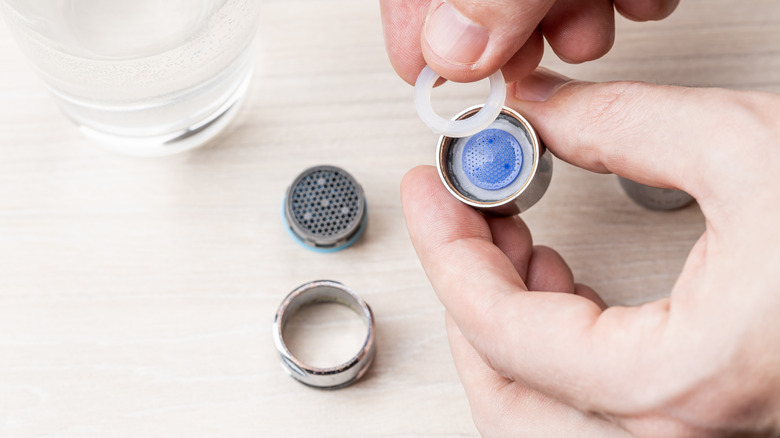Faucet Aerators: Here's What You Should Know Before Installing One
People love to makeover their bathrooms, and for good reason: It's a total different experience showering in an upgraded bathroom, one that is devoid of cracked ceramic tiles and outdated bathtubs. But while many people are willing to splurge on bathroom features, there is one small feature in particular that often gets overlooked when it's time to go to the maintenance store: That important feature is the faucet aerator.
Faucet aerators are round gadgets that are installed on the ends of faucets that channel the water into a steady stream. Without an aerator, your faucet will still deliver water, but the stream will sputter and splash. According to Plumbing & A/C Medic, Inc.., the aerator does this by reducing the volume of water that comes out of the faucet, which in turn helps to conserve water (and lower your water bill). In fact, aerators can reduce the amount of water by 30% or more (via Home Water Works).
Faucet aerators are definitely a bathroom and kitchen staple, and if your faucet doesn't already have one installed, then here is what you should know before installing one.
Be aware of flow rates when installing an aerator
While aerators seem like simple enough gadgets to buy, there are some things to research and nail down before you head out to the hardware store to pick out an aerator. For example, you want to be conscious of your required flow rates. People like to use specific gallons-per-minute (GPM) minimums when washing up or filling pots, so you want to make sure you're not choosing an aerator that will deliver water at a significantly slower rate than you need. If you do choose such an aerator, then you might be stuck standing by the sink for a very long time while filling up your spaghetti pot! Daniel O'Brian, a technical specialist with Supply House, told Bob Vila to choose an aerator that releases water between 1 and 1.5 GPM in the kitchen, and .5 to 1 GPM in the bathroom.
You will require faster amounts of water in the kitchen then you would need in the bathroom, which is why it would be beneficial to get different types of aerators for those two different taps.
Aerators come in different sizes
In addition to knowing how many GPMs you require, you should also know what size of aerator you will need. Faucets come in all sorts of shapes and sizes, which is why there are three different aerator sizes available. According to New Resources Group, aerators come in three sizes: standard, junior, and Tom Thumb. To help you visualize the different available sizes, take out some of your pocket change. The aerators are approximately the diameter of a quarter (standard), a nickel (junior), and a dime (Tom Thumb).
In addition to the diameter of your spout, you will also have to know if your faucet has a "male" or "female" spout. According to Danco, you can find out whether you have a "male" or "female" spout by locating the spout's threads, which are the grooves found at the end of the spout. If your faucet has its threads on the outside then it has a "male" spout and requires a "female" aerator, but if it has threads on the inside then it is a "female" spout and needs a "male" aerator.
Aerators provide different kinds of streams
You will also want to take a moment to consider what kind of water stream you would like your aerator to provide. According to Neoperl, a plumbing component manufacturer, there are three different stream designs to choose from. The "aerated" stream is the most common stream seen in households. Air is introduced to the water flow, causing the water to come out in even, pressurized streams that are soft to the touch. You know if you have aerated water if it comes out of the tap in a white stream. On the other hand, a "laminar" stream doesn't mix air with water, letting the stream come out crystal clear. The laminar stream also differs from the aerated flow by offering more gallons-per-minute (GPM).
The last stream is the "spray" stream, and it is used in faucets that require very little GPMs. The aerator creates a shower-like stream to make it appear like you're still using an appropriate amount of water, and Neoperl recommends using this pattern in public restrooms. While these are the three most common stream designs, certain aerator brands will offer singular designs that are unique to their companies, like Neoperl's "rain spray" stream for instance.
Some aerators are more eco-conscious than others
While faucet aerators help to reduce water waste and lower energy consumption, not all of them are created equally. If you are installing a faucet aerator to become more eco-friendly, then look for aerators that specifically have the WaterSense stamp. These stamps indicate that the product meets U.S. Environmental Protection Agency (EPA) standards for being water–efficient. The EPA explains that the standard flow of a faucet uses 2.2 gallons per minute, but approved aerators use a maximum of 1.5 gallons per minute. This could lead to billions of gallons of water saved each year if every household across the country invested in a faucet aerator.
All products with a WaterSense stamp complete a certification process that tests whether or not the product meets the agency's standards and saves water the way it claims to on its packaging. By buying products with this label, you can be rest assured that you're buying a high-performing aerator.
Aerators will require maintenance
Even though a faucet aerator is small, it will still require some maintenance upkeep. Aerators can accumulate mineral deposits and mildew buildup, which is why it is important to clean faucet aerators once a quarter. If you don't clean the aerator then that debris and mildew will continue to stay at the tip of the faucet, allowing water to filter through it.
Luckily for us, though, it is very easy to clean an aerator: Take a wrench to unscrew the gadget from the tip of the faucet, and once the aerator is detached, simply wipe it down with water and soap. Make sure you clean the build up from in between the separate parts, and twist it back onto the faucet (per Kitchn).
While faucet aerators are simple devices, they aren't a one-size-fits-all gadget. But with this faucet aerator guide, you can walk into a big box store knowing you're getting exactly what you need.
